This is the story of a magnificent eight-day bivouac hike through the Écrins National Park. The trail we followed partly overlaps the better-known Tour des Écrins, but the entire first part of our itinerary was our own. In my opinion, it's one of the most beautiful mountain trekking trails to do in France. Here are some brief tips and information if you're interested in hiking it:
- Bivouac : As always, I chose bivouac as a hiking method to make the most of nature. In the Écrins park, it is allowed from 7 p.m. to 9 a.m., more than an hour's walk from the road access. The weight of our bags was between 10 and 15 kg all inclusive. A good tent to learn how to bivouac is that of Decathlon for two people : we find lighter but it has the advantage of being spacious and inexpensive.
- Refueling : There is a mini-market halfway along the trek at La Chapelle en Valgaudemar, which allows you to carry 4 days of food at most.
- Material : If you want to do this route in bivouac you will of course need a tent and a good sleeping bag (it can be cold at night at altitude, I recommend 0 degree comfort). For the evening, it's nice to have a stove and a saucepan to make hot food (pasta, polenta, soup, risotto, etc.)
- Departure in Embrun and arrival in Bourg-d'Oisans
- Difficulty: This crossing of the Écrins requires good physical fitness, our stages being sometimes long (but of course, with the bivouac it is possible to adapt the itinerary to your taste!). The descent of the Col de Prelles is tricky, you must not be afraid of heights and know how to orient yourself in the mountains.
Now let’s talk about this hike!
Attention : Part of the route is off-trail. This requires a good sense of direction. The route may be very imprecise because it is drawn manually (not recorded on the ground).
Les Écrins in bivouac, day 1: Mont Guillaume
+ 1750 m / – 250 m 14km
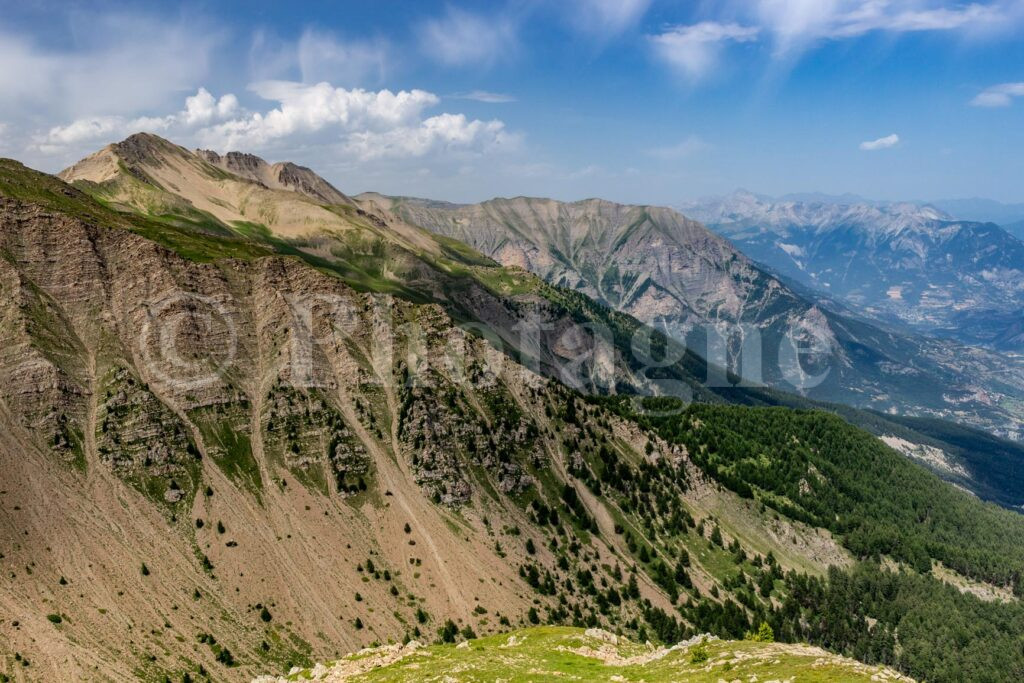
We leave from Embrun, a pleasant town next to Lake Serre-Ponçon. Since the starting point is quite low (800m), we try to leave as early as possible to escape the heat. Fortunately, the path passes through the undergrowth quite quickly, which allows us not to suffer too much. The climb is long but simple: we have to reach Mont Guillaume above the valley, a 1750m elevation gain! A small oratory as we emerge from the woods makes a good spot for a picnic break. Then a final climb as we emerge from the woods allows us to reach Mont Guillaume, from where the view of the Durance Valley, the surrounding peaks and Lake Serre-Ponçon is truly panoramic.
We then follow a very pretty ridge path and then go back down to the Col de Trempa, where we start our first off-trail section. Indeed, there are not many paths in this remote corner but the terrain is quite easy. This allows us to easily reach a small lake ideal for bivouacking. It's nice to dip your feet in the water while eating after such a sweat!
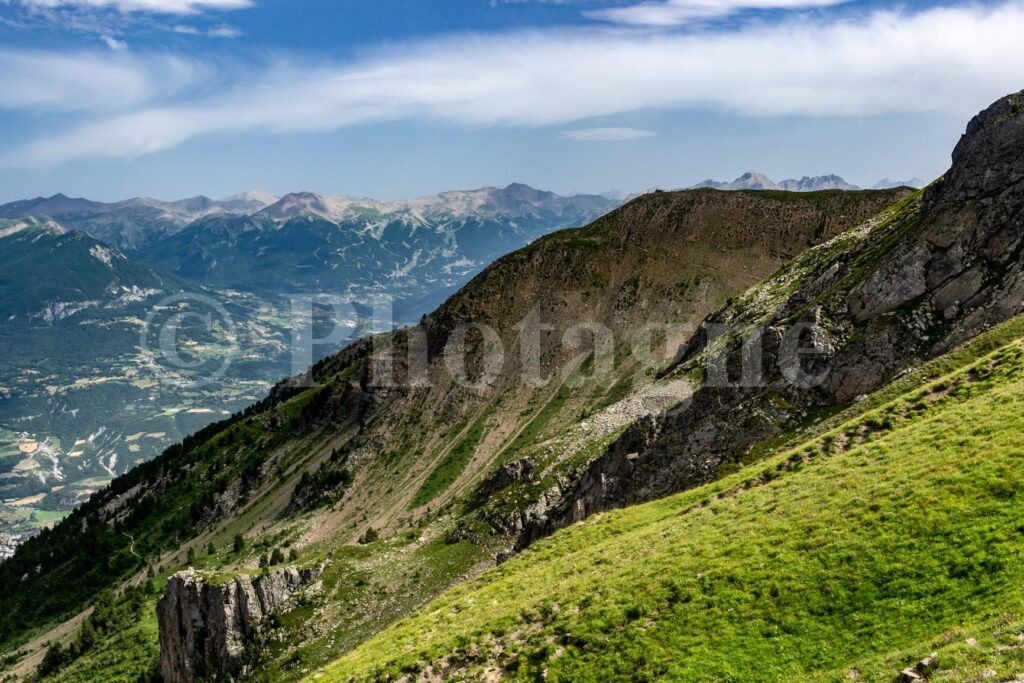
Day 2: Mourre Froid
+ 1400 m / – 1150 m 16km
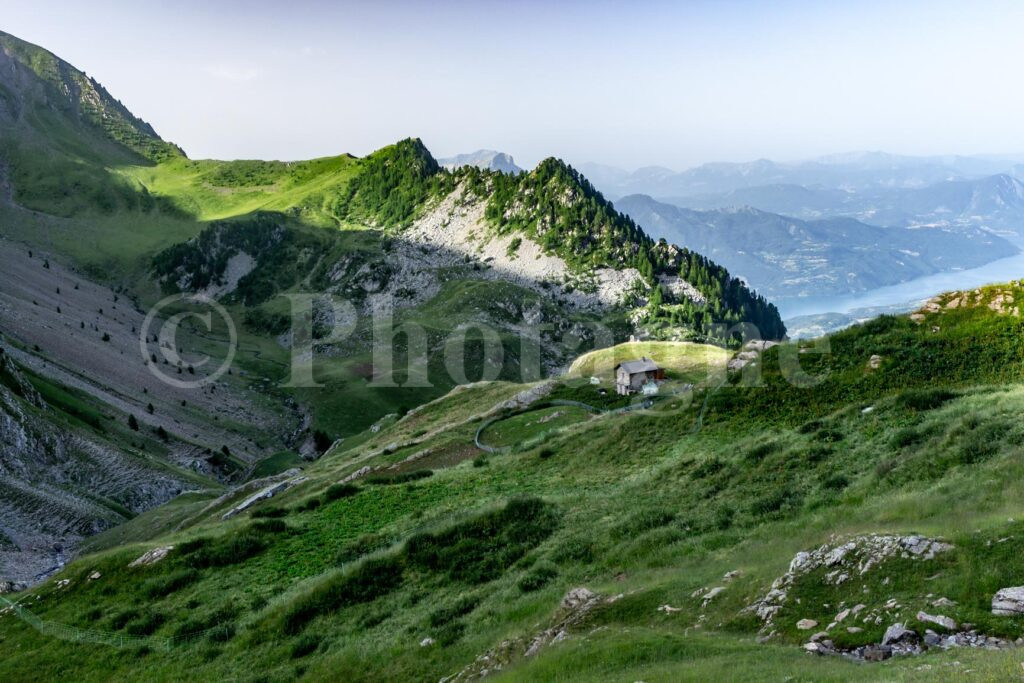
We set off again off-trail, in very damp grass, to finally join a path that climbs from the valley towards the Reyssas pass. There is a pretty mountain hut with its flock of sheep around it. At the pass, a very alpine landscape is revealed, with meadows as far as the eye can see. We go back down into the valley first by following the path, then by cutting a little through the mountain pastures to join another path going up to the Règue pass.
The peaks that reveal themselves are impressive, all rocks without a trace of vegetation. We can see the sun beating down in summer and the wind blowing in winter... The folds and geological layers are clearly visible.
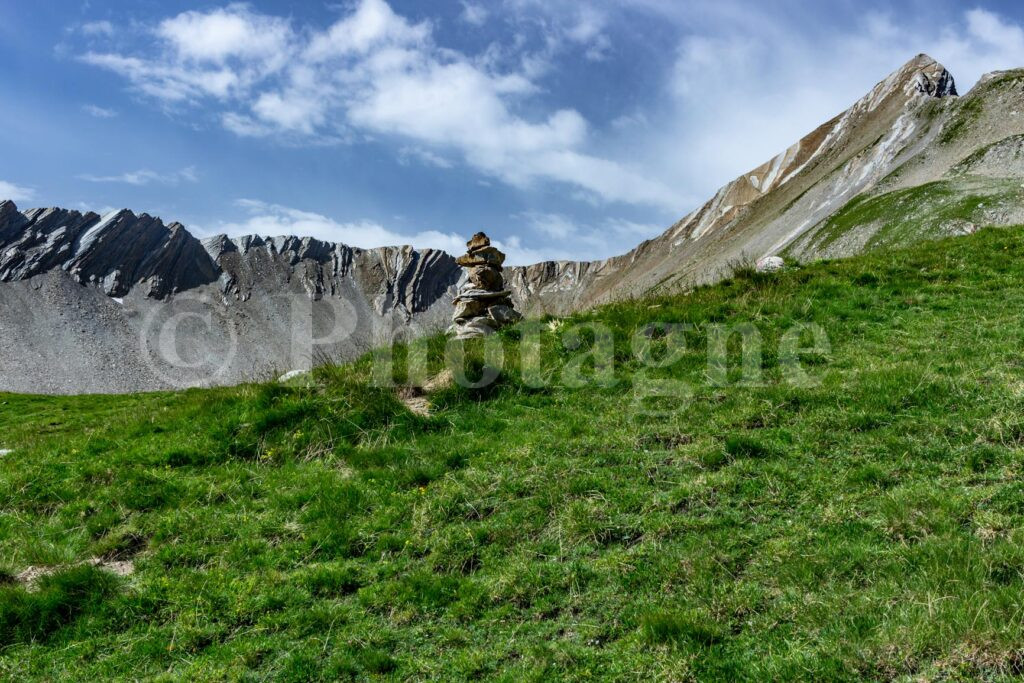
At the pass, we enjoy a first view of the Écrins, all white in the distance. This is the course we must keep for our hike. We then follow the very easy ridge that takes us to Mourre Froid. It deserves its name: it's freezing! We shelter from the wind behind the big cairn to eat.
Then we descend along the other ridge, following a better-marked path. Honestly, the landscape is a little too rocky for me; I'm a bit bored. But for those who like rocks, it must be great...
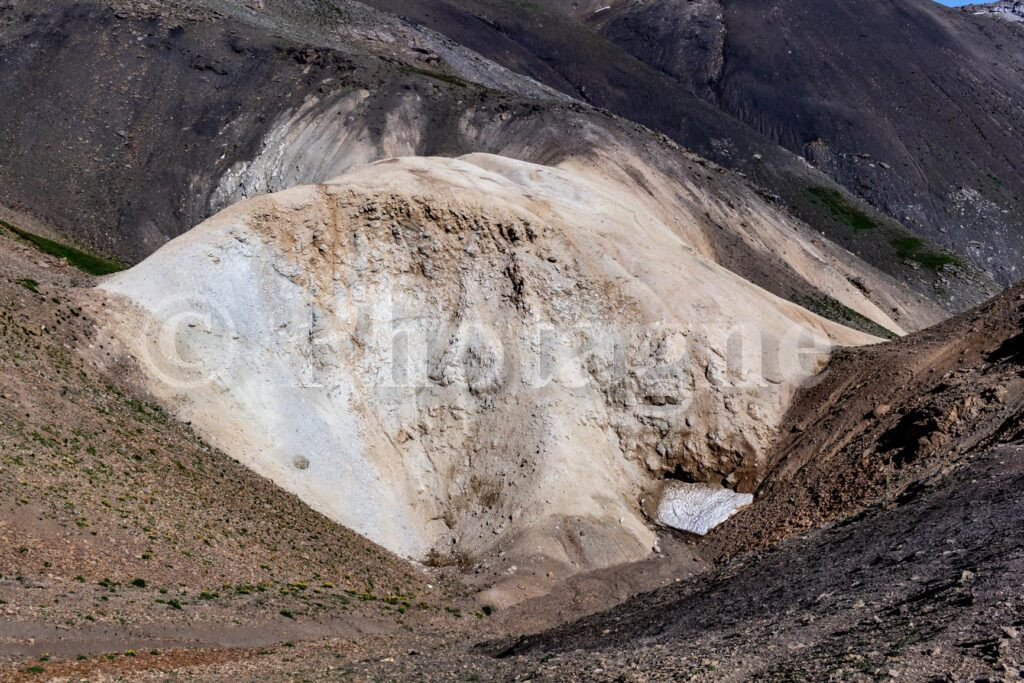
To our left stretches the Laire Valley, and in the distance we see the Col des Terres Blanches, our destination. Another name that aptly describes the place (there's gypsum), which is plentiful in the area.
We then go up a looooong valley to reach the pass. It's beautiful but the end of the day is making itself felt. Especially since we never see the pass coming, we think it's going to be around the next bend and... not at all.
We finally cross the pass and stop shortly afterwards, in a pretty high-altitude meadow where there is no shortage of springs.
Day 3: Dormillouse and the Prelles pass
+ 1300 m / – 1700 m 22 km
The morning descent into the Dormillouse Valley is enchanting. We cross beautiful meadows, the grass then becomes denser. We pass waterfalls. Then a pretty pond, and finally the larch forest. We arrive at the village at the perfect time for a blueberry tart break.
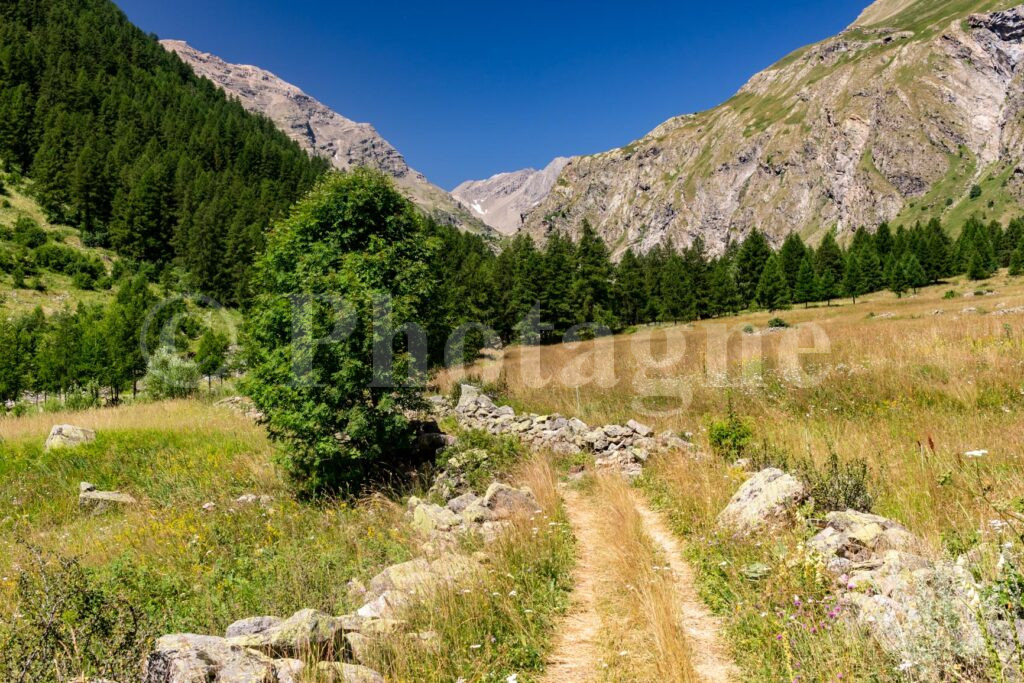
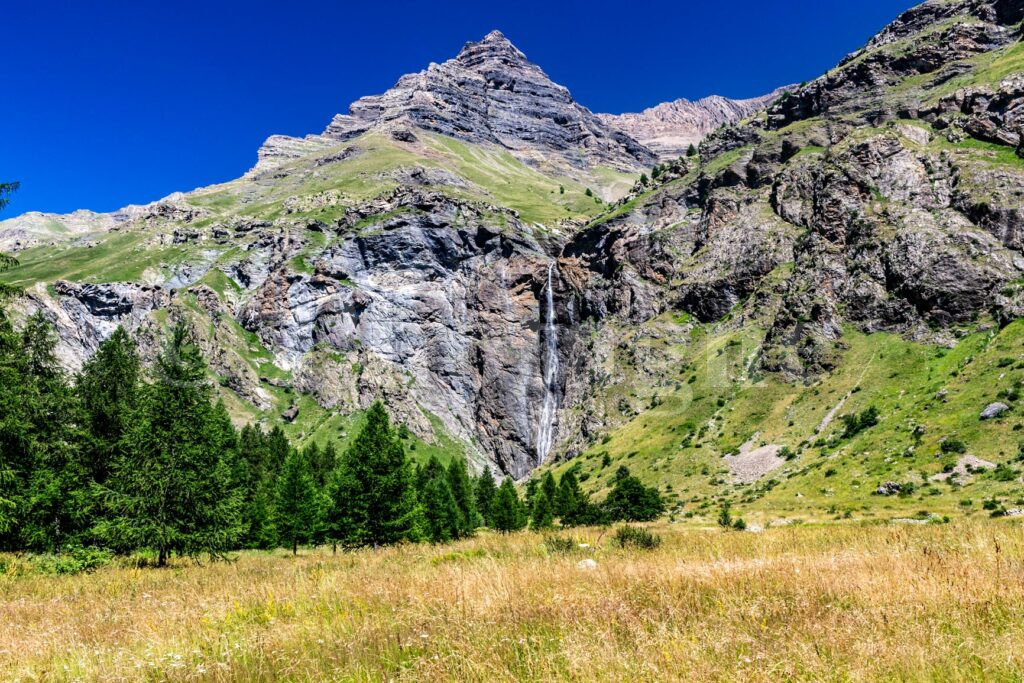
Dormillouse is a beautiful hamlet, one of the few villages in France that is not accessible by road. We pass by beautiful dry stone houses with wooden upper floors. Then we continue our way in the Chichin Valley. We alternate between meadows, forests and views of waterfalls: it is simply superb. We eat on the banks of a small stream.
We finally finish climbing this beautiful valley to reach the Col d'Orcières. A quick descent to Lac des Estaris, after which we climb back up to the Col de Prelles. The view of the Écrins in the late afternoon is breathtaking.
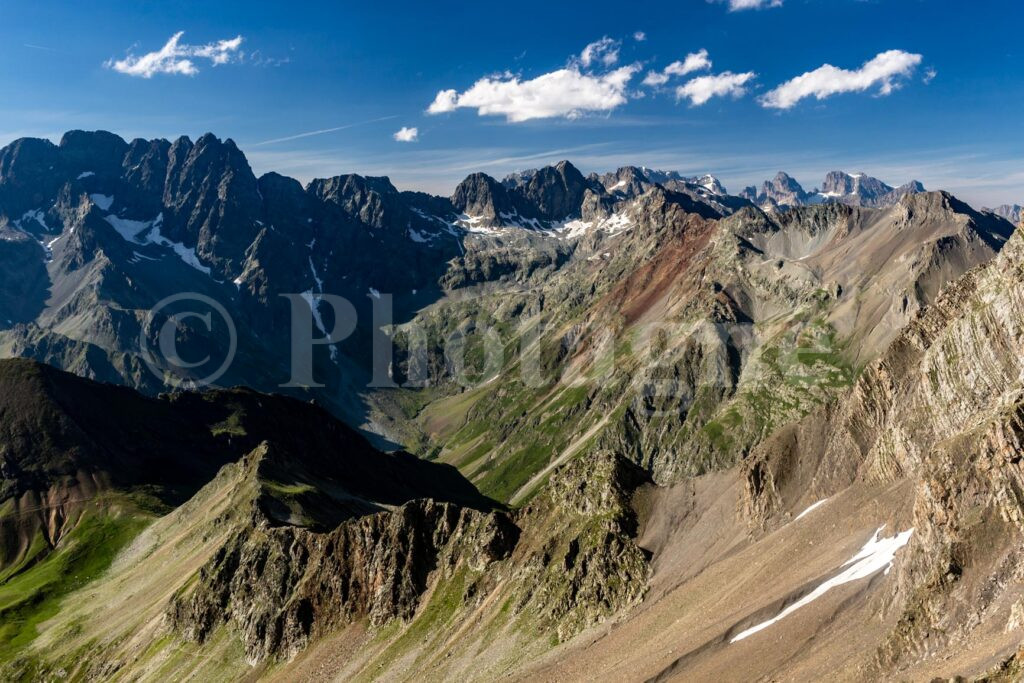
However, the most technical section of our bivouac crossing of the Écrins awaits us: descending the Col de Prelles. It is indeed a fairly steep descent in the middle of rocky ledges. You have to be careful of the risk of falling rocks. In addition, the path is really not easy to find in places, you have to spot the cairns and use your GPS (track indicated on OpenStreetMap).
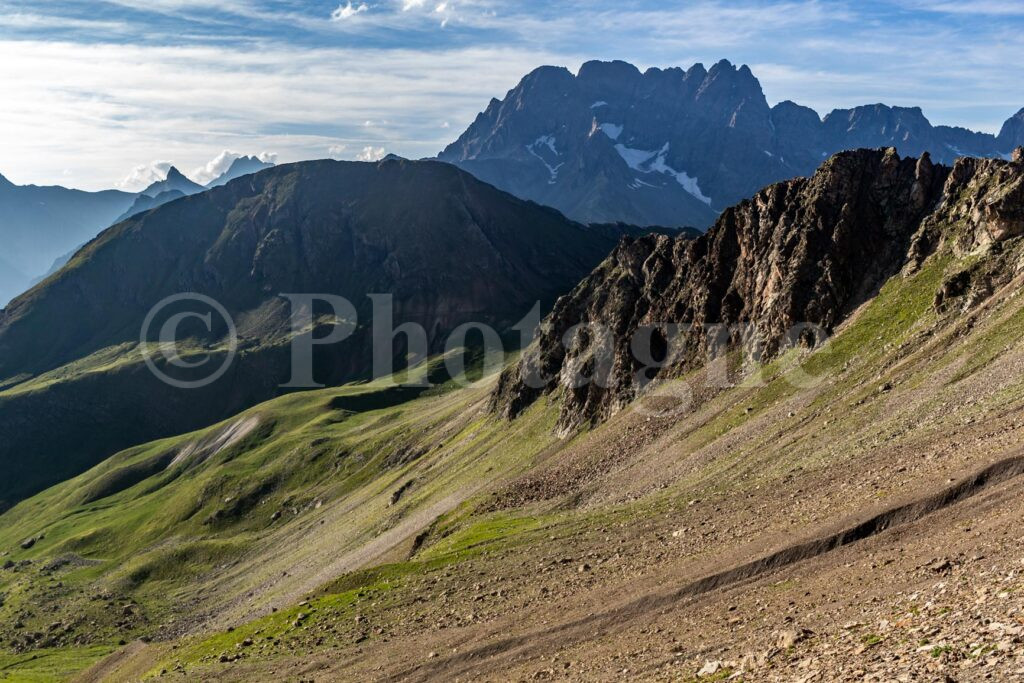
We reach the bottom of the ledge after some rather steep scree slopes. We then have to follow the scree slope on the right. Three large trenches cut the path, with a little snow at the bottom. We finally arrive tired at the Col du Cheval de Bois. A wooden horse, like an old-fashioned toy, awaits us at the pass, which can be added to the list of explicit names.
We finally descend the Rougnoux valley and set up camp at the first possible spot. It's a raised grassy strip with a large spring along the path. The sunset over the rocks behind us is beautiful. This bivouac is one of my favorites on the route.
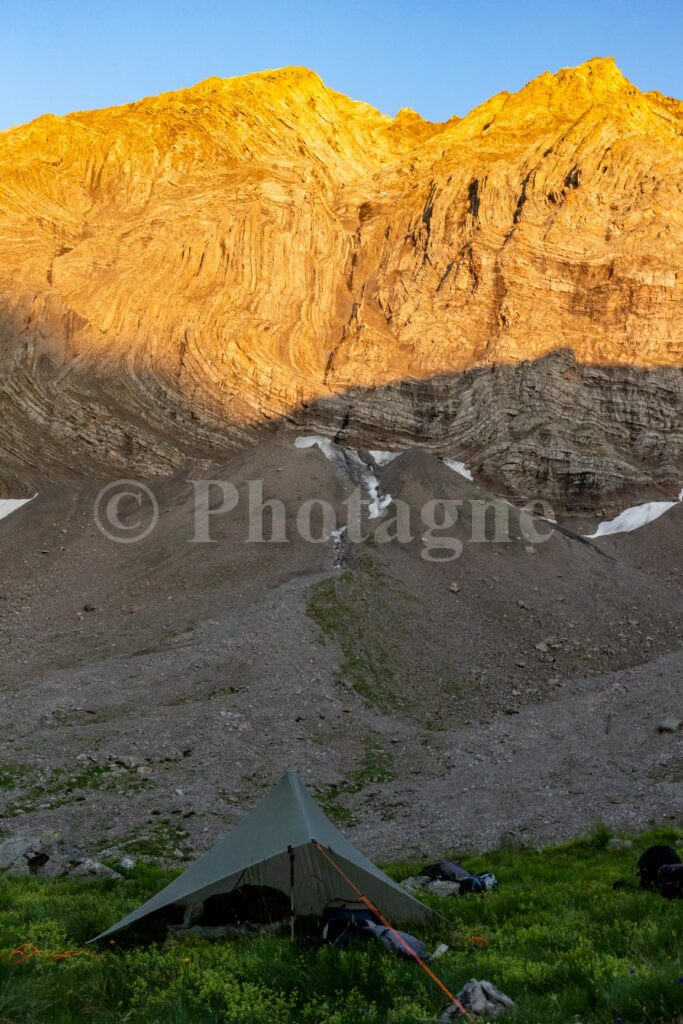
Day 4: where we join the Écrins tour in bivouac
+ 1150 m / – 2100 m 23km
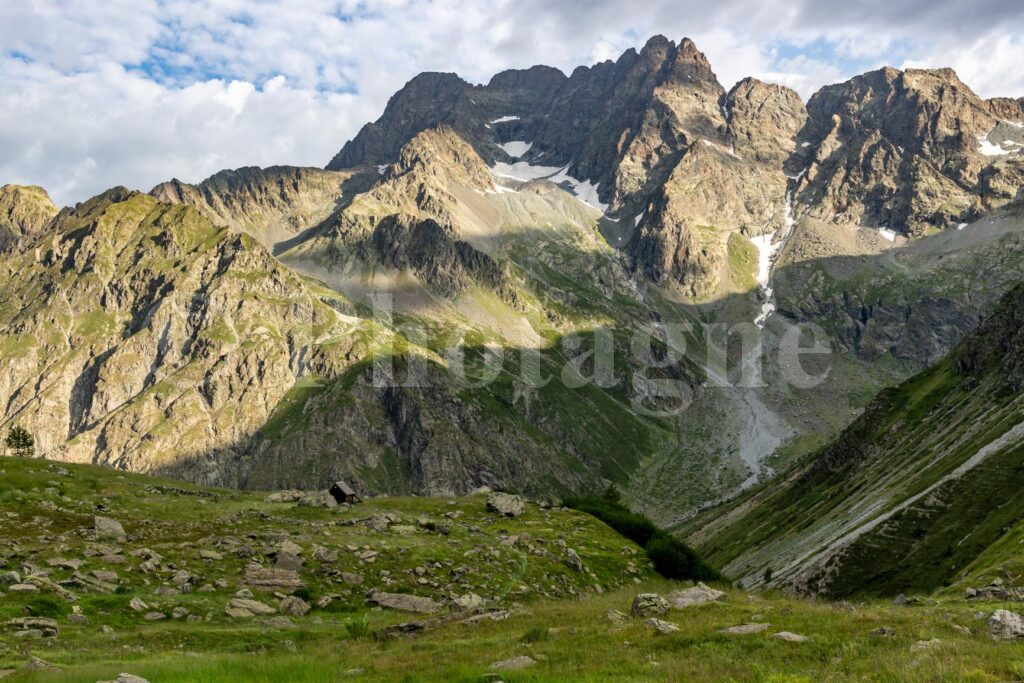
Near the tents, we chat with a friendly shepherd who explains to us the misdeeds of the wolf in the area. He tells us that the shepherd's life was much easier without its presence, but that we have to deal with it now.
We then descend the valley to arrive at Pré de la Chaumette. We are now on the "official" route of the Tour des Écrins, which we will follow to Bourg d'Oisans. This of course means that the number of hikers along the path will be multiplied by at least ten. We arrive at the refuge shortly after everyone has already left for the day's stage. No matter: we catch up with quite a few of them on the climb to the Col de la Vallette!
The landscape is breathtaking, alternating between scree and meadows. The sun breaks through the clouds and creates large patches of light.
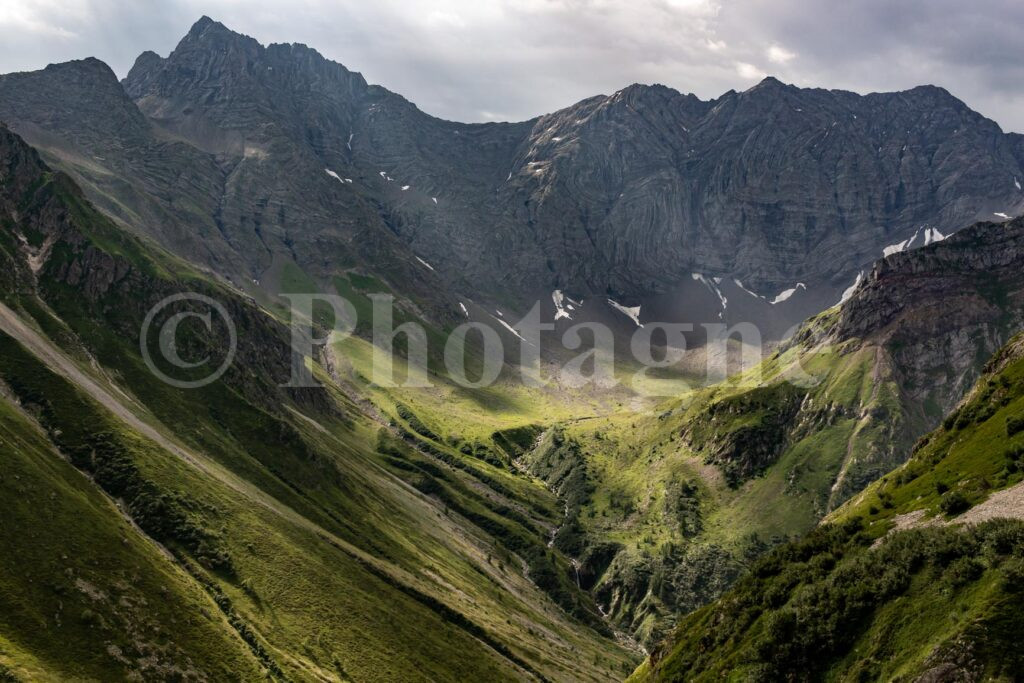
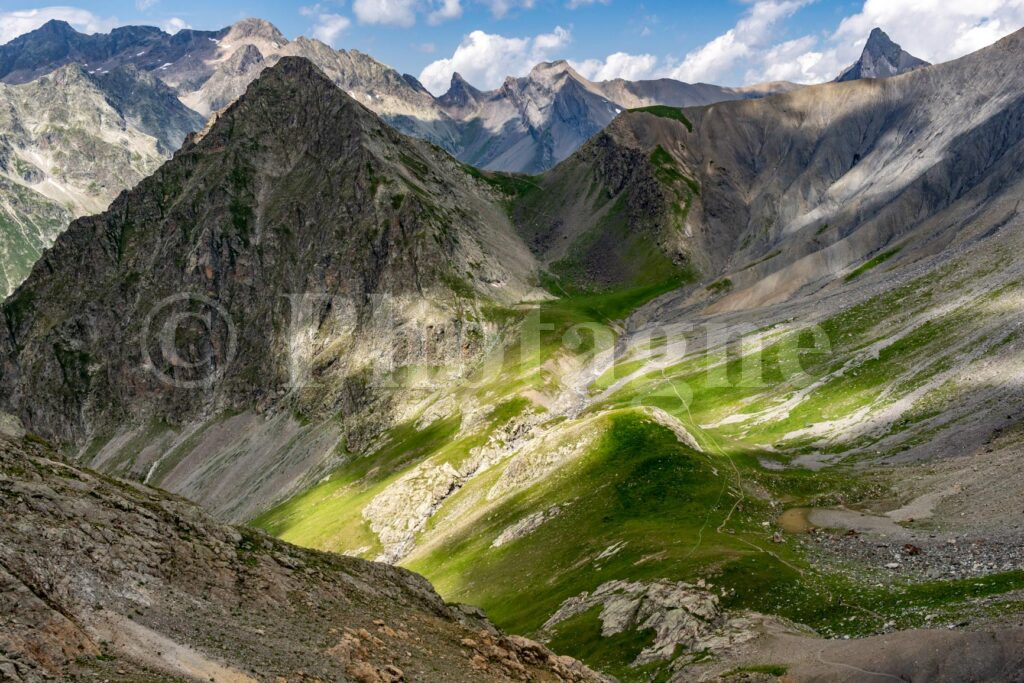
From the pass, we descend through schist to cross a very pretty little hanging valley: the Gouiran valley. Another pass, then we approach Vallon Plat. Here the landscape is truly superb, between the intense green of the meadows and the gray-black of the rocks behind. The latter form strange folds.
We eat at the bottom of the valley, then it's back up to pass the third and last pass of the day: the Vallonpierre pass. A short descent takes us to the Vallonpierre refuge, with a well-deserved blueberry tart.
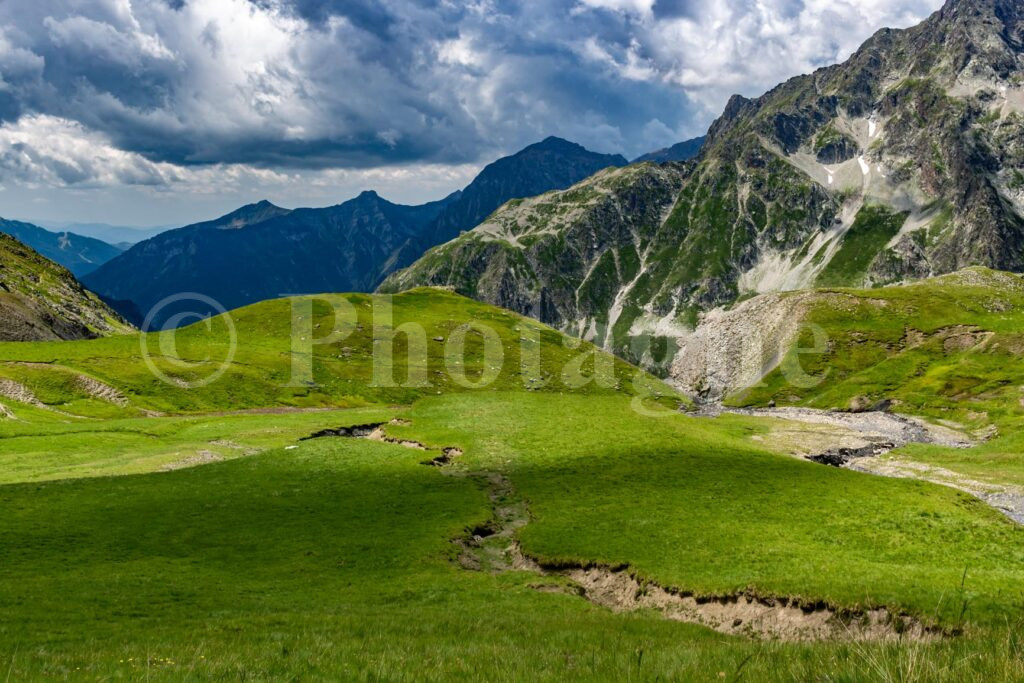
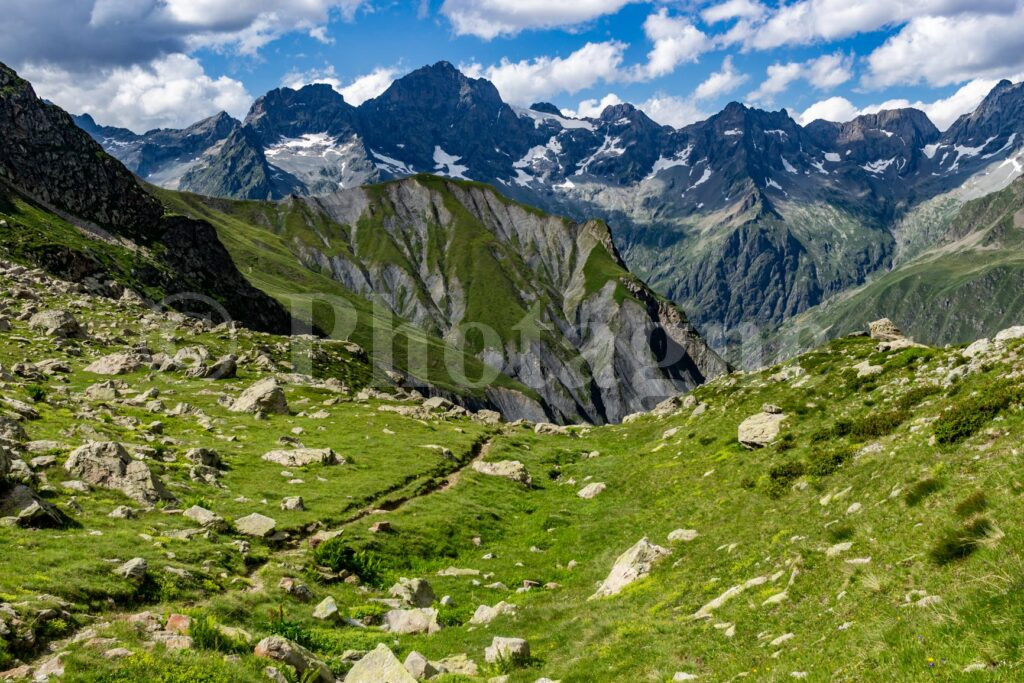
We then descend into the Valgaudemar. The light is magnificent, the Écrins just in front: one of the highlights of the route. We really feel surrounded by giants in this valley with its very steep walls. All in all, it is for me the most beautiful day of this crossing of the Écrins in bivouac.
I would recommend a bivouac stop somewhere on the way down from the refuge (there are plenty of places), but unfortunately we have to continue. Indeed, one of us is finishing his trip at La Chapelle en Valgaudemar and has to take the bus quite early tomorrow. So we do a fairly long stage that takes us to the bottom of the valley.
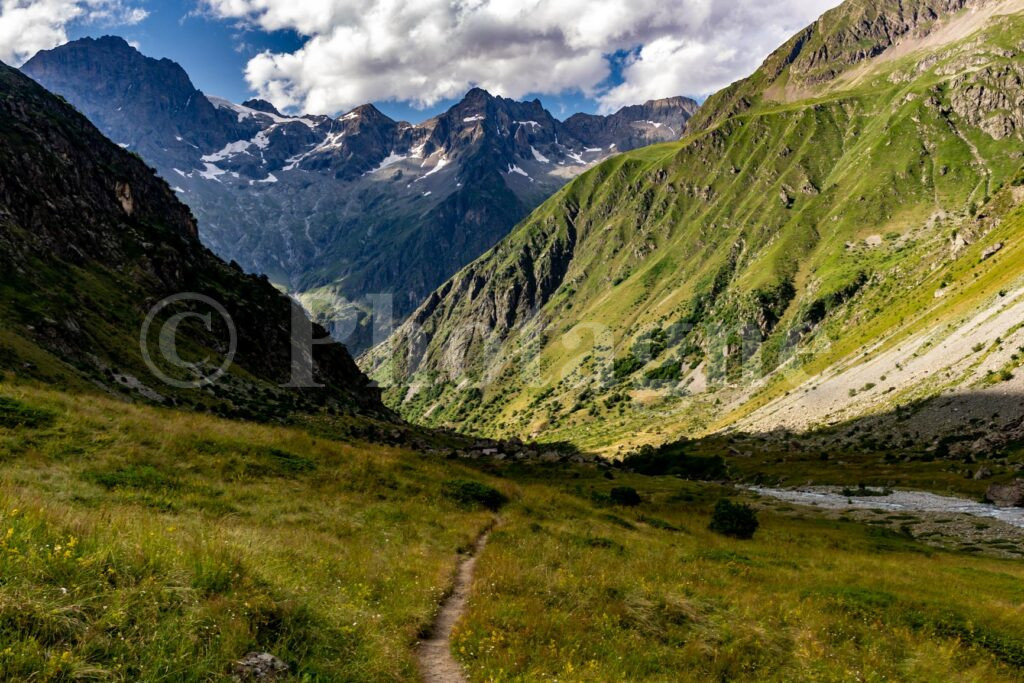
We finally camp near the river, at a lower altitude. Not the most beautiful bivouac of the trip, but it's still very peaceful.
Day 5: The Chapel in Valgaudemar
+ 1500 m / – 650 m 17km
We quickly packed up camp and arrived early in the morning at La Chapelle en Valgaudemar. A quick stop for a delicious hot chocolate, time to do some shopping for the next 4 days, and here we are again on the crossing of the Écrins in bivouac.
We climb steeply along a stormy torrent. We make a slight variation compared to the Tour des Écrins, which allows us to pass closer to the Olan.
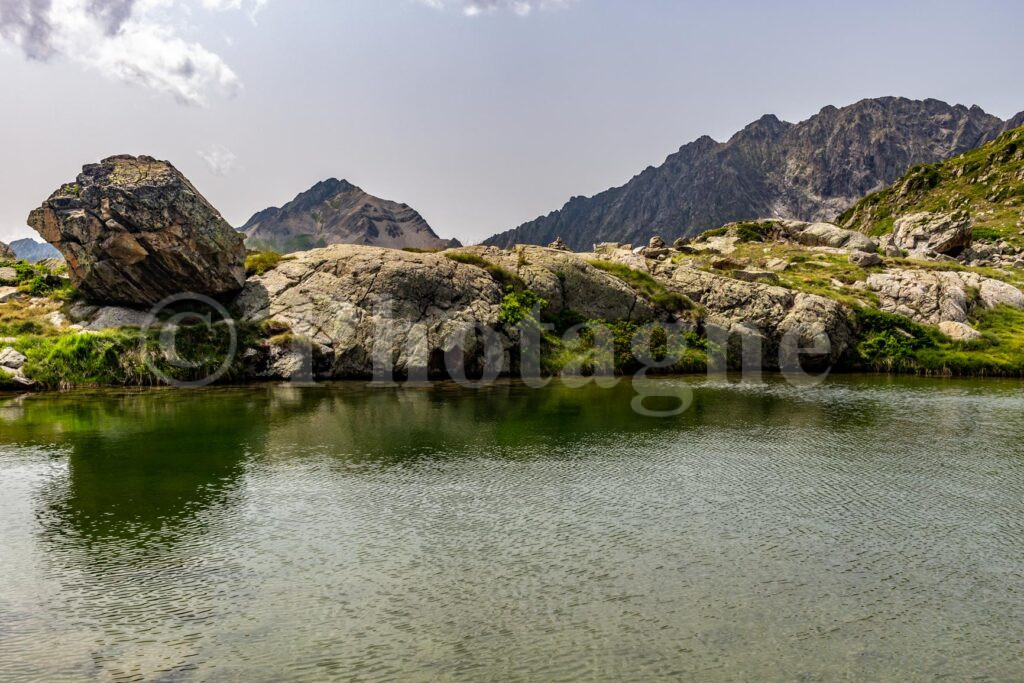
After the Col de Colombes, the landscape becomes more bucolic, winding between rocks to finally arrive at the edge of small lakes. The view over the large, deep valley of Valgaudemar is impressive.
We cross a small pass to finally arrive at the Souffles refuge. In order not to change our habits, we have a small blueberry tart. Then we leave most of the hikers who stop at the refuge. Our thirst for nights in the wilderness is too great: we want a quiet spot for the bivouac!
We find it about an hour further on, in a hanging valley called Périnon. It is without a doubt the most beautiful bivouac of this crossing of the Écrins: we hover in this small grassy valley, well above the Valgaudemar, with a superb view of the Sirac in the distance.
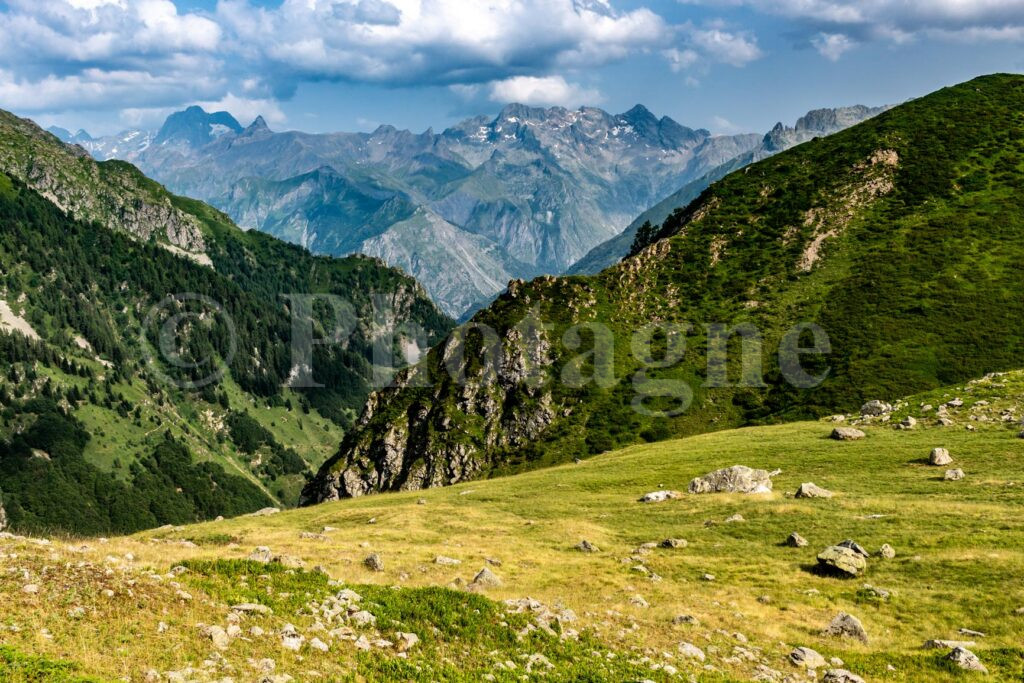
Day 6: The Desert in Valjouffrey
+ 1450 m / – 2150 m 16km
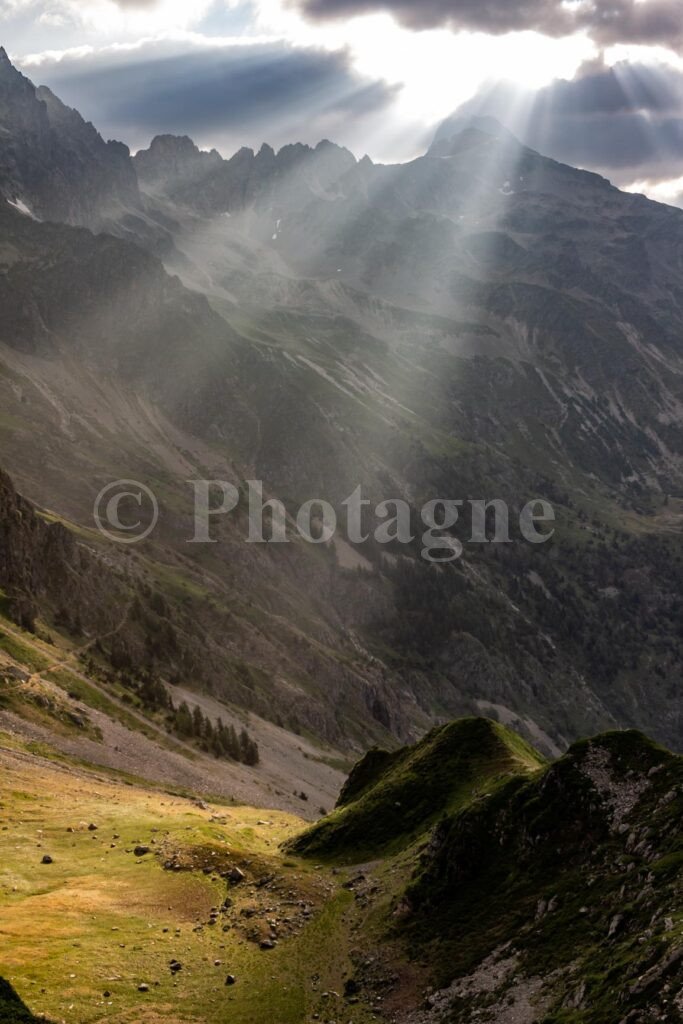
We leave our beautiful valley with regret at dawn and quickly reach the Col de la Vaurze. The descent that follows is direct and very steep: the 1000m of elevation gain makes us feel our knees! Arriving at the village of Désert en Valjouffrey, we take a well-deserved swim in the torrent. It's invigorating!
The route that follows is quite simple: climb 1000m to the Col de Côte Belle, descend to the next village, climb 1300m to the Col de la Muzelle (the next day). The climb to Côte Belle is nothing extraordinary, but the descent passes through some very impressive schists. It really looks like a giant mille-feuille.
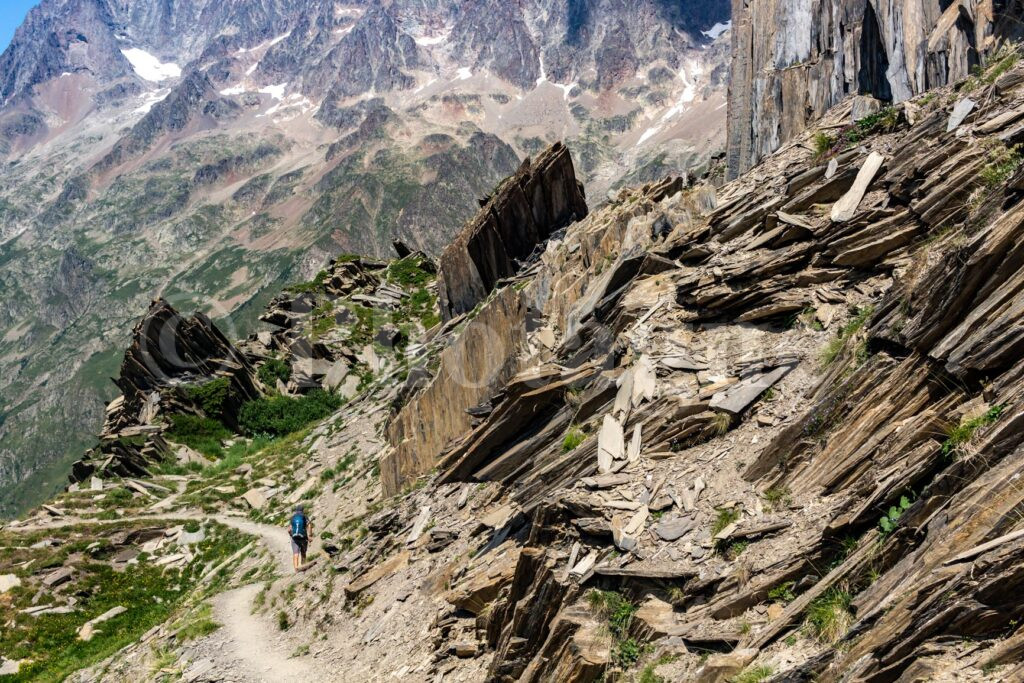
Exhausted, we arrive at Valsenestre, where we find an “official” bivouac area. Not bad, I must say, even if I always prefer bivouacs in the middle of nature, far from everything. We can chat quietly with the neighbors in the evening.
Day 7: La Muzelle
+ 1700m / – 1550m 14km
Quite a few clouds this morning. We leave early hoping to avoid the rain to cross the pass. Despite the graying light, the climb is superb. Especially the last part, which climbs very steeply in the schists: from below, we even wonder how it can pass so steep it is! But the path is well marked.
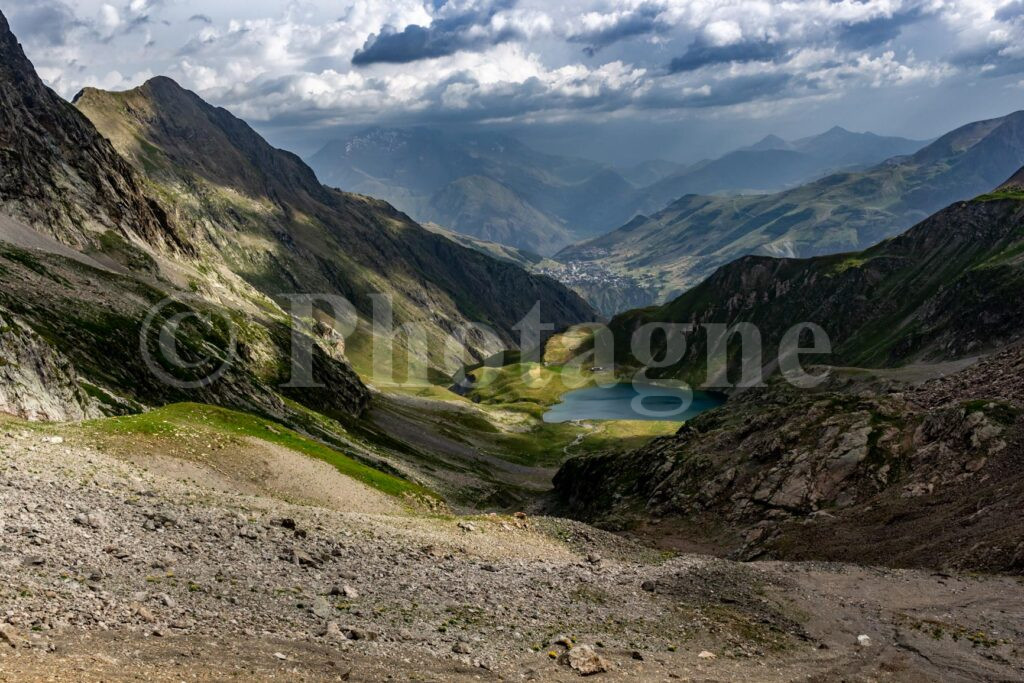
At the pass, the wind is so strong that we hardly stay. However, the play of light on the lake is beautiful, especially with a thunderstorm in the background. Fortunately, the storm passes in the distance and avoids us.
A quick blueberry tart at the refuge (we're not going to change a good habit), then we set off again for the rest of the trail. Very beautiful views of the Meije are revealed on the way. We pass the Col du Vallon, then it's a big descent to the Lac du Lauvitel.
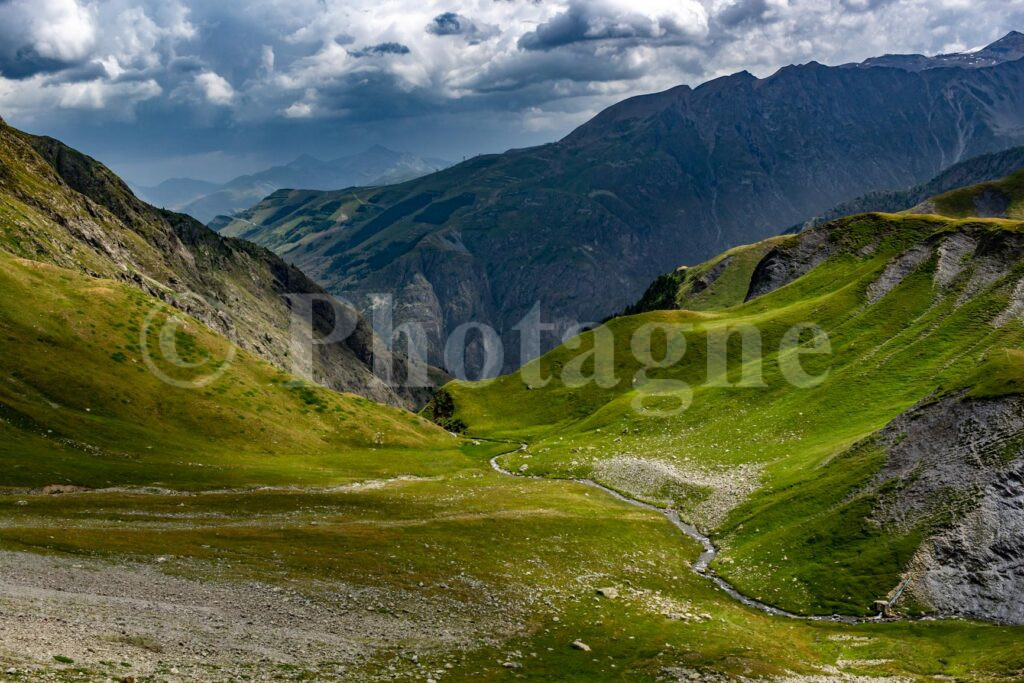
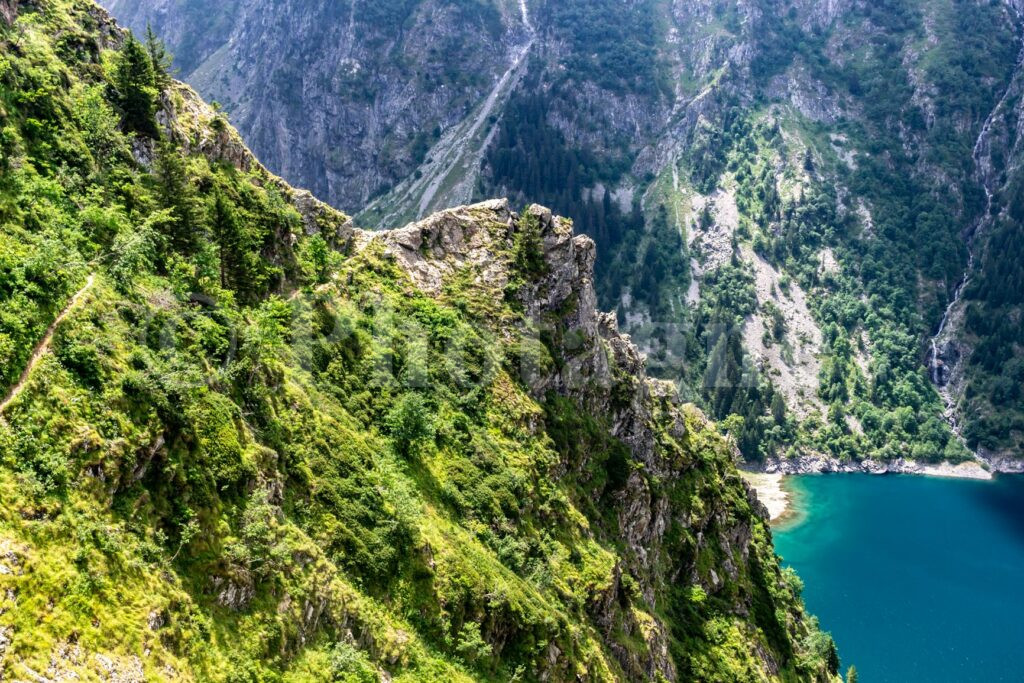
The end of the descent is very beautiful, the path passes skillfully in the middle of very steep slopes above the lake. We finally arrive at the edge of the lake, where a bivouac area awaits us. It is a superb location, and what a pleasure to swim a little after such a descent!
Day 8: Bourg d'Oisans and end of the Écrins crossing in bivouac
+ 50 m / – 850 m 12km

A violent storm passes during the night. Fortunately the tents are solid. In the morning, we are in the clouds which sometimes burst to reveal magnificent lights. It is our last bivouac, and we can't help but feel a little sad after such an epic. We fold up the tent one last time then go back down to the bottom of the valley.
On the way, we come across a man with a mule who is carrying food for one of the houses near the lake. No other way to get it there indeed!
We finally reach the valley and walk a few kilometers in a pretty forest along the river. Then it is Bourg d'Oisans which marks the final stage of our journey. What a variety of landscapes along this crossing of the Écrins in bivouac! I hope you enjoyed this description, and do not hesitate to leave your comments on our itinerary.
Looking for more great hiking routes in the Alps? Take a look at my trekking in the Dolomites !
If you liked the landscape photographs on this page, please take a look at the section Pictures. For example, you can order a mountain poster of my photos, which is a good way to support me ;).
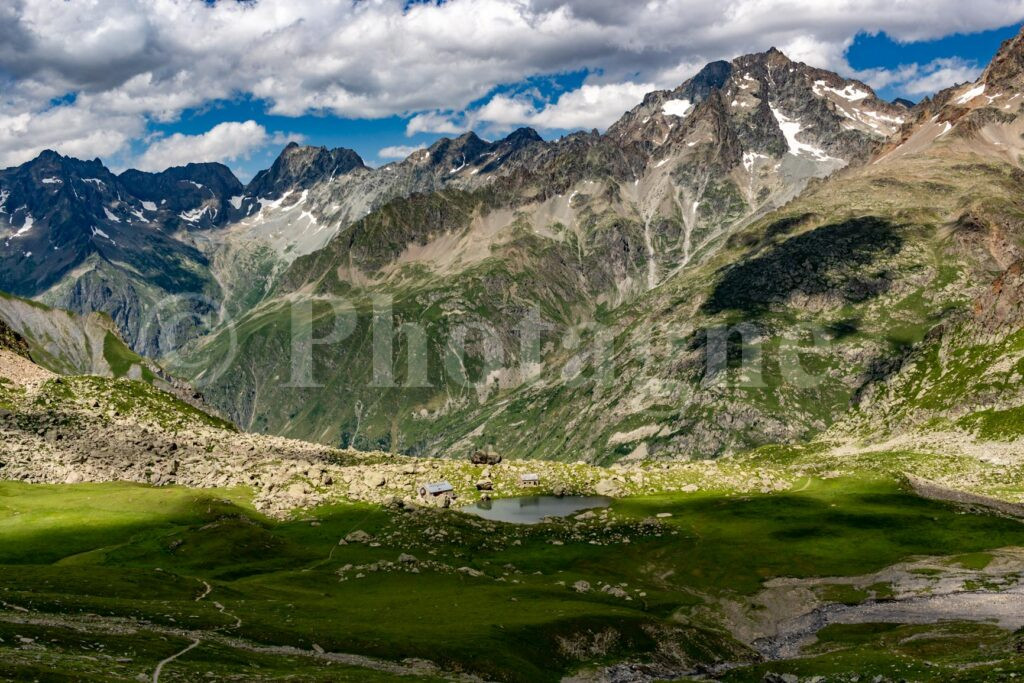
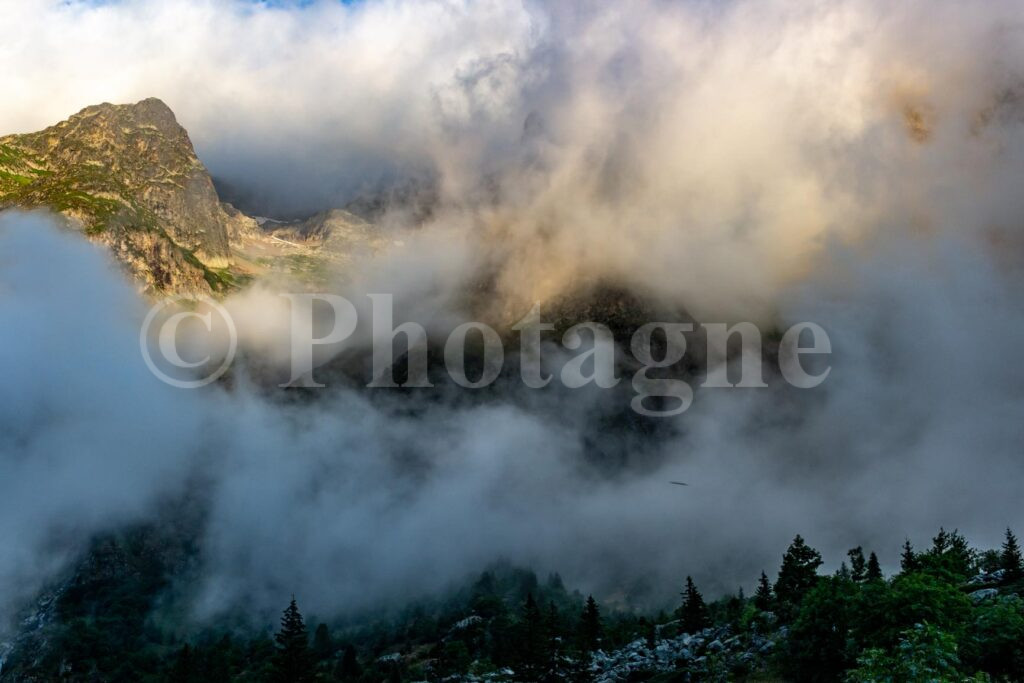
2 Comments
Florence · 12 June 2025 at 19h54
Thank you for this account of your “modest but brilliant” adventure, I read and reread it with pleasure. I really like your tone and of course the photos. I have 2 questions: in what season did you do it? The light in the photos looks like late summer/autumn. And also, is the GPX your actual journey?
Photagne · 12 June 2025 at 20h44
Hello Florence, and thank you for the comment, it makes me happy! To answer your questions:
1) I did this trail at the end of July, I think it is doable from the beginning of July to the end of September (depending on the snow cover of the year). The highest point is the Mourre froid at almost 3000m.
2) For the GPX, I traced it “by hand” with a mapping app after the hike, from memory. I have a good memory ;). But it is possible that the route is a little imprecise, especially in off-trail sections or when there are many small parallel trails. I would advise always referring to a reading of the terrain and having a good map with you.
Happy hiking and please feel free to post another comment if you complete part of this trail!